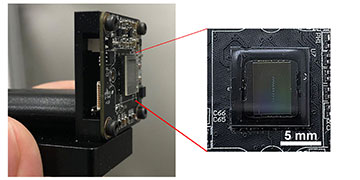Researchers at Nanjing University in China have demonstrated a very small camera made from an array of 17 metalenses that can produce much clear images over wide angles than a device based on a single metalens. Their new planar camera (MIWC) produced clearer images of pictures projected across a curved screen compared to a camera based on a single traditional metalens. [Image: T. Li, Nanjing University] [Enlarge image]
Rather than employing the often bulky, heavy optics used in conventional cameras, a group of researchers in China has shown how to create a high-quality wide-angle image using an array of metalenses just a fraction larger and thicker than a postage stamp (Optica, doi: 10.1364/OPTICA.446063). They reckon their new device could have a range of applications, from smartphone photography to sensing in confined spaces.
Avoiding bulkiness
Wide-angle lenses are used by many photographers to capture images of sweeping landscapes or building interiors. They are also useful for the machine vision of self-driving cars or drones. However, to compensate for distortions that occur when focusing light rays from grazing angles, the wide-angle lenses are usually compound in nature. This makes them more cumbersome than standard lenses.
Researchers have tried to replace these fish-eye lenses with metalenses. Rather than relying on bulk glass to bend light waves, such devices instead use large numbers of tiny, subwavelength “meta-atoms” positioned in specific configurations on a flat substrate to alter light’s phase in a pre-determined way.
However, single metalenses suffer from essentially the same problem as individual conventional glass lenses—being unable to properly focus rays from acute angles. Attempts to modify these lenses, such as making doublets or combining them with an aperture, have either proved tricky to realize or have led to other imaging defects.
Modifying phase profiles
In the latest work, Tao Li and colleagues at Nanjing University in China instead use an array of metalenses. Their idea is to precisely vary the phase profile from one lens to the next such that each focuses light from a certain range of viewing angles. The output from the different lenses is then combined to create an image over a wide angle.
The researchers fabricated a metalens array (shown on the right) and mounted it directly to a CMOS sensor. The metalens array is shown on the right. This created a planar camera that measured about 1 cm × 1 cm × 0.3 cm. [Image: T. Li, Nanjing University] [Enlarge image]
The researchers made their array by etching nanometer-sized posts of silicon nitride on a substrate of silicon dioxide. Each lens relied on a different combination of eight meta-atoms to achieve phase shifts between 0 and 2 π. The resulting array of 17 lenses was then attached directly to a CMOS imaging sensor—yielding a device just 1 cm2 and 3-mm thick.
To put their device through its paces, Li and co-workers first investigated how well it focused. Taking light from a 470-nm laser and using an adjustable mirror to vary the angle of incidence, they found that their array was able to generate a sharp focal spot over a much wider range of angles than a single metalens with the same diameter and focal length. They also showed that the array’s modulation transfer function—a measure of contrast produced by a lens—dropped off far more slowly at higher resolutions than did that of the individual lens.
Wide angle for small spaces
To use the device for imaging they “stitched” together the output from the different lenses. This involved masking the extremities of each individual image to leave just the clearest part in each case, and then superimposing the masked images to leave a single wide-angle image.
They projected the words of their institution—Nanjing University—over a curved screen and positioned their device 15 cm from the screen so that the words extended over a viewing angle of 120°. Doing so, they were able to generate a high-quality image, within which all of the 17 letters were clearly visible. Using a single metalens with a conventional hyperboblic phase profile, in contrast, they were limited to a 40-degree field of view that comprised just half a dozen of the letters.
Possible applications of the device, they say, including sensing in environments where little space is available—such as inside small elevators or in a battery module. Alternatively, the array could be mounted on drones to provide accurate navigation and positioning information.
First, however, the researchers need to improve the device’s performance. In particular, they plan on enlarging the lenses from a current miniscule diameter of 0.3 mm to several millimeters. They add that there is nothing in principle preventing them from adding enough lenses to the array that they can capture images over a full 180°. This will require laying out the array on a curved substrate, just as fish-eye devices employ curved lenses, but reckon that improved fabrication techniques ought to make this possible in future—something, they note, that would be difficult to do for a single metalens.


